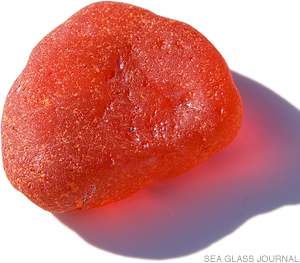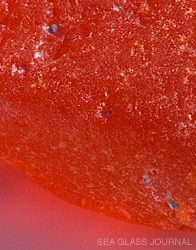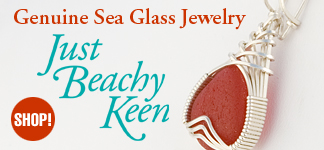The Sea Glass Shard of the Month: October 2015
An Orange Sea Glass Campfire Melt

Sea Glass Specifications:
Color: Orange
Max Length: 42.9 mm (1.69")
Max Width: 36.6 mm (1.44")
Max Thickness: 12.7 mm (0.50")
Weight: 29.4 grams (1.03 oz)
Estimated Age: Undetermined. Due to its unique color it is believed to have been before the 1940s.
For the month of October we've chosen a rare orange colored sea glass melt from the coast of New Brunswick, Canada. Because it has been deformed so completely, its origins can only be guessed at as possibly a large glass automobile reflector or some tableware object dating before the 1940s.
Campfire sea glass, also know as bonfire sea glass or a sea glass melt, are shards of glass that have been melted by exposure to high heat from a fire, usually located near the coast, eventually finding its way into the ocean to be conditioned and frosted by the surf.

As this detail shows, campfire glass is often embedded with ash from the fire as well as sand and small stone from the beach.
Campfire sea glass often "originate from glass bottles thrown into a campfire or larger bonfire... but can also come from controlled dump fires... on the coast..."
These pieces most often originate from glass bottles thrown into campfires or larger bonfires by "coastal socialites", but can also come from controlled coastal dump fires initiated by towns that discarded their refuse on the coast or nearby islands as in the case of this month's specimen.
Pieces of campfire glass can be recognized due to their deformed or amorphous shaped, often embedded with ash from the fire as well as sand and small stone from the beach.
They may also contain more than one color due to different colored glass objects being in close proximity to one another during a burn.
Depending on the conditions of the fire - how hot and for how long it burned - the origins of the glass shards may still be determined. Often bottle or tableware segments, while deformed, may still have recognizable attributes.
It is assumed that in most cases the color of the glass has not been altered, but I can't say with absolute certainty that in a few instances, the color has not been modified ever so slightly by exposure to temperatures high enough to melt the glass. One must remember that in glass manufacturing, heat, oxygen supply and duration all affect the color of glass.
If you come across such a piece of sea glass while strolling the beach take a moment to look around. Maybe it would be a fine place to have your very own little campfire while enjoying the sunset, sounds of the surf and ocean breeze.
Keep up-to-date on all things sea glass... like us on Facebook!
Sea Glass Journal on Facebook







